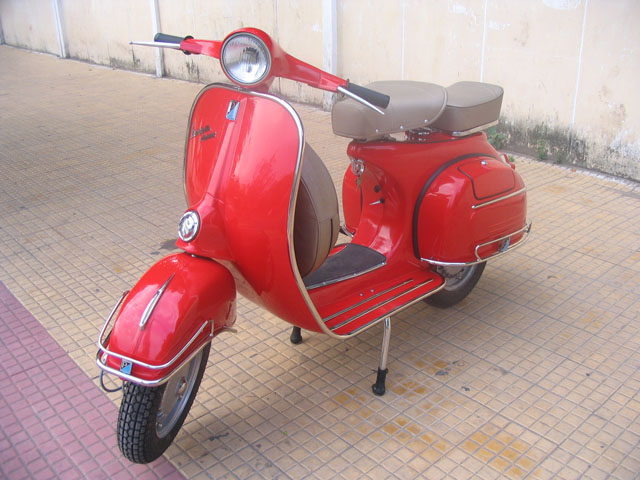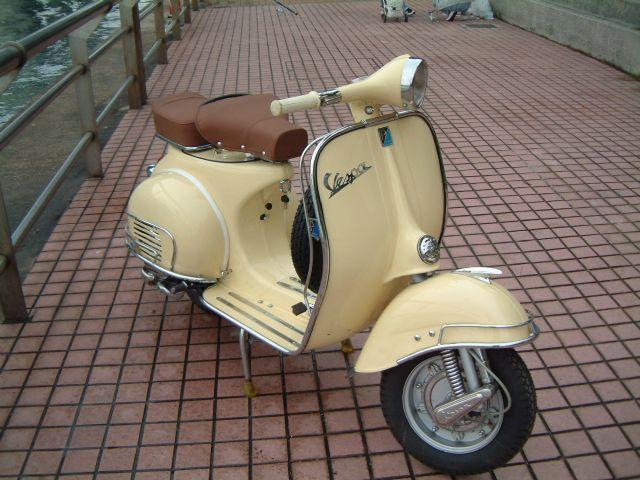The Vespa is a line of motor scooters that was first manufactured in Pontedera,
Italy in 1946 byPiaggio & Co. S.p.A.

Piaggio continues to manufacture the Vespa today, although the Vespa was much more widely used in the 1950s and 60s, when it also became the adopted vehicle of choice for the UK youth culture known as Mods. The classic Vespas had unibody chassis pressed from sheets of steel, with bodywork covering the legs for protection from rain and mud. The direct drive engine was covered completely by a steel cowling to appeal to a broader market of people, often turned off by the dirty/greasy stereotype often applied to motorcycles. Piaggio revolutionized the two-wheel industry with the Vespa and provided a model on which nearly every other scooter made since has been based.
History

Post World War II Italy, in light of its agreement to cessation of war activities with The Allies,
had its aircraft industry severely restricted in both capability and capacity.
Piaggio emerged from the conflict with its Pontedera fighter plane plant completely demolished by bombing. Italy's crippled economy and the disastrous state of the roads did not assist in the re-development of the automobile markets. Enrico Piaggio, the son of Piaggio's founder Rinaldo Piaggio, decided to leave the aeronautical field in order to address Italy's urgent need for a modern and affordable mode of transportation. The idea was to design a cheap vehicle for the masses.
Concept
The main stimulus for the design style of the Vespa dates back to Pre-WWII Cushman scooters made in Nebraska, USA. These olive green scooters were in Italy in large numbers, ordered originally by Washington as field transport for the Paratroops and Marines. The US military had used them to get around Nazi defence tactics of destroying roads and bridges in the Dolomites (a section of the Alps) and the Austrian border areas.
Aeronautical engineer Corradino D'Ascanio, responsible for the design and construction of the first modern helicopter by Agusta, was given the job of designing a simple, robust and affordable vehicle for Enrico Piaggio. The vehicle had to be easy to drive for both men and women, be able to carry a passenger, and not get its driver's clothes dirty.
The product

D'Ascanio, who hated motorbikes, designed a revolutionary vehicle. It was built on a spar-frame
with a handlebar gear change, and the engine mounted directly on to the rear wheel. The front
protection "shield" kept the rider dry and clean in comparison to the open front end on motorcycles. The pass-through leg area design was geared towards all user groups, including women, as wearing dresses or skirts made riding a motorcycle a challenge. The front fork, like an aircraft's landing gear, allowed for easy wheel changing. The internal mesh transmission eliminated the standard motorcycle chain, a source of oil, dirt, and aesthetic misery.
This basic design allowed a series of features to be deployed on the frame, which would later allow quick development of new models. The original Vespa featured a rear pillion seat for a passenger, or optionally a storage compartment. The original front protection "shield" was a flat
piece of aero metal; later this developed in to a twin skin to allow additional storage on the 'back of'/behind the front shield, similar to the glove compartment in a car. The fuel cap was located underneath the (hinged) seat, which saved the cost of an additional lock on the fuel कैप or need for additional metal work on the smooth skin.
The scooter had rigid rear suspension and small 8-inch wheels that allowed a compact design and plenty of room for the rider's legs. The Vespa's enclosed, horizontally-mounted two-stroke 98cc engine acted directly on the rear drive wheel through a three-speed transmission. The twistgrip-controlled gear change involved a system of rods. The early engine had no cooling, but
fan blades were soon attached to the flywheel (otherwise known as the magneto, which houses the points and generates electricity for the bike and for the engine's spark) to push air over the
cylinder's cooling fins. The modern Vespa engine is still cooled this way. The mixture of two-stroke oil in the fuel produced high amounts of smoke, and the engine made a high buzzing
sound like a wasp.
The name Vespa

"Sembra una vespa!" ("It reminds me of a wasp!") exclaimed president Enrico Piaggio when he first laid eyes on what would become the most successful scooter of all time. The name stuck
Vespa is both Latin and Italian for wasp—derived from both the high-pitched noise of the two-stroke engine, and adopted as a name for the vehicle in reference to its body the shape
thicker rear part connected to the front part by a narrow waist, and the steering rod resembled
antennae.
Italy in 1946 byPiaggio & Co. S.p.A.

Piaggio continues to manufacture the Vespa today, although the Vespa was much more widely used in the 1950s and 60s, when it also became the adopted vehicle of choice for the UK youth culture known as Mods. The classic Vespas had unibody chassis pressed from sheets of steel, with bodywork covering the legs for protection from rain and mud. The direct drive engine was covered completely by a steel cowling to appeal to a broader market of people, often turned off by the dirty/greasy stereotype often applied to motorcycles. Piaggio revolutionized the two-wheel industry with the Vespa and provided a model on which nearly every other scooter made since has been based.
History

Post World War II Italy, in light of its agreement to cessation of war activities with The Allies,
had its aircraft industry severely restricted in both capability and capacity.
Piaggio emerged from the conflict with its Pontedera fighter plane plant completely demolished by bombing. Italy's crippled economy and the disastrous state of the roads did not assist in the re-development of the automobile markets. Enrico Piaggio, the son of Piaggio's founder Rinaldo Piaggio, decided to leave the aeronautical field in order to address Italy's urgent need for a modern and affordable mode of transportation. The idea was to design a cheap vehicle for the masses.
Concept
The main stimulus for the design style of the Vespa dates back to Pre-WWII Cushman scooters made in Nebraska, USA. These olive green scooters were in Italy in large numbers, ordered originally by Washington as field transport for the Paratroops and Marines. The US military had used them to get around Nazi defence tactics of destroying roads and bridges in the Dolomites (a section of the Alps) and the Austrian border areas.
Aeronautical engineer Corradino D'Ascanio, responsible for the design and construction of the first modern helicopter by Agusta, was given the job of designing a simple, robust and affordable vehicle for Enrico Piaggio. The vehicle had to be easy to drive for both men and women, be able to carry a passenger, and not get its driver's clothes dirty.
The product

D'Ascanio, who hated motorbikes, designed a revolutionary vehicle. It was built on a spar-frame
with a handlebar gear change, and the engine mounted directly on to the rear wheel. The front
protection "shield" kept the rider dry and clean in comparison to the open front end on motorcycles. The pass-through leg area design was geared towards all user groups, including women, as wearing dresses or skirts made riding a motorcycle a challenge. The front fork, like an aircraft's landing gear, allowed for easy wheel changing. The internal mesh transmission eliminated the standard motorcycle chain, a source of oil, dirt, and aesthetic misery.
This basic design allowed a series of features to be deployed on the frame, which would later allow quick development of new models. The original Vespa featured a rear pillion seat for a passenger, or optionally a storage compartment. The original front protection "shield" was a flat
piece of aero metal; later this developed in to a twin skin to allow additional storage on the 'back of'/behind the front shield, similar to the glove compartment in a car. The fuel cap was located underneath the (hinged) seat, which saved the cost of an additional lock on the fuel कैप or need for additional metal work on the smooth skin.
The scooter had rigid rear suspension and small 8-inch wheels that allowed a compact design and plenty of room for the rider's legs. The Vespa's enclosed, horizontally-mounted two-stroke 98cc engine acted directly on the rear drive wheel through a three-speed transmission. The twistgrip-controlled gear change involved a system of rods. The early engine had no cooling, but
fan blades were soon attached to the flywheel (otherwise known as the magneto, which houses the points and generates electricity for the bike and for the engine's spark) to push air over the
cylinder's cooling fins. The modern Vespa engine is still cooled this way. The mixture of two-stroke oil in the fuel produced high amounts of smoke, and the engine made a high buzzing
sound like a wasp.
The name Vespa

"Sembra una vespa!" ("It reminds me of a wasp!") exclaimed president Enrico Piaggio when he first laid eyes on what would become the most successful scooter of all time. The name stuck
Vespa is both Latin and Italian for wasp—derived from both the high-pitched noise of the two-stroke engine, and adopted as a name for the vehicle in reference to its body the shape
thicker rear part connected to the front part by a narrow waist, and the steering rod resembled
antennae.




1 komentar:
The company dotes on the recent launched of vespa, after a long period of time we have seen the model on the road. And, I think, the tussle time has been over after being revealed the new model.
Posting Komentar